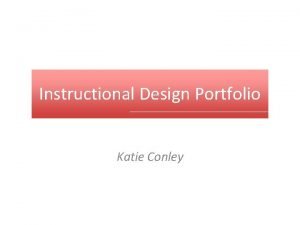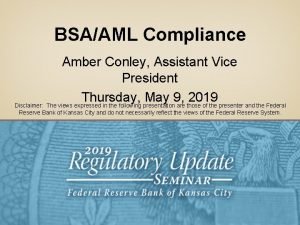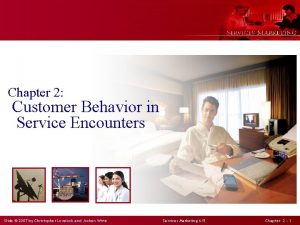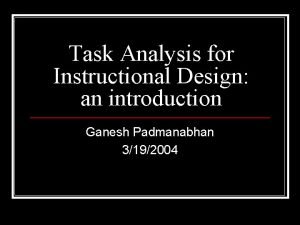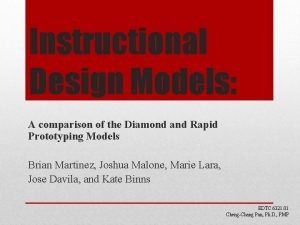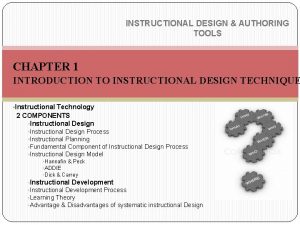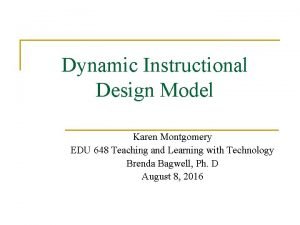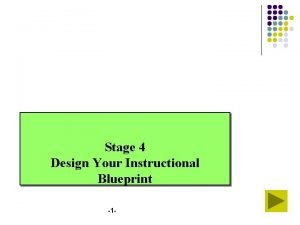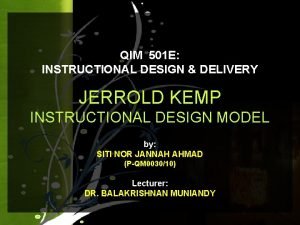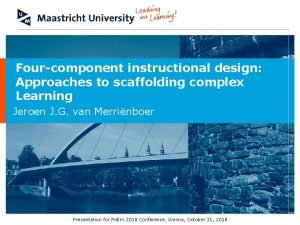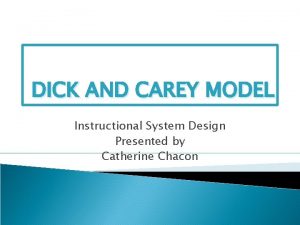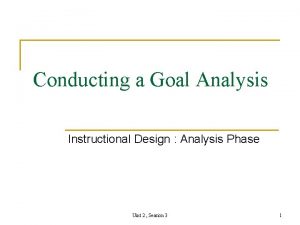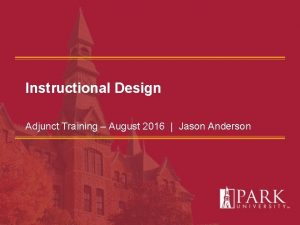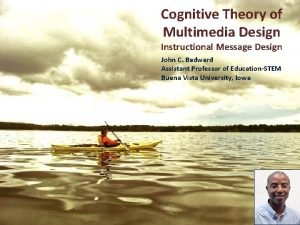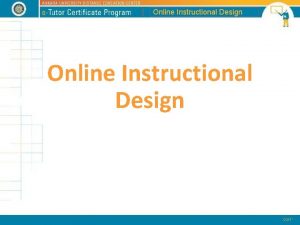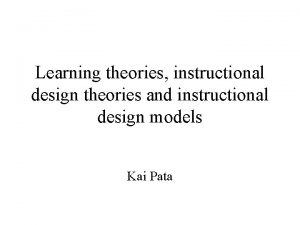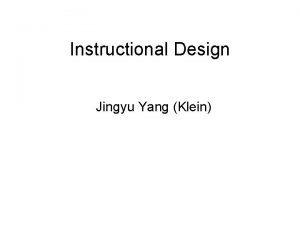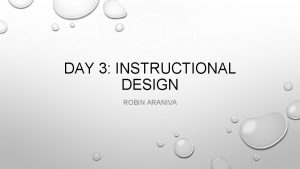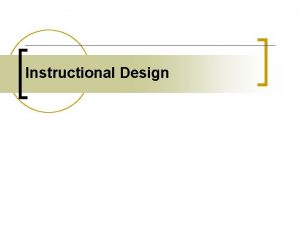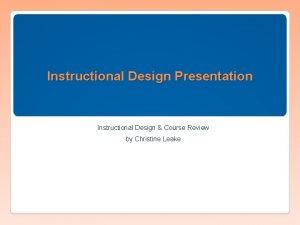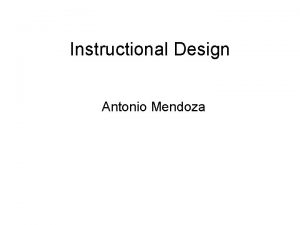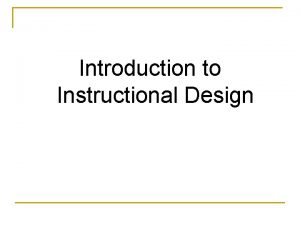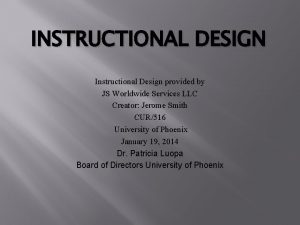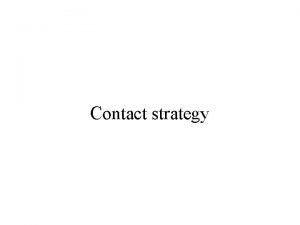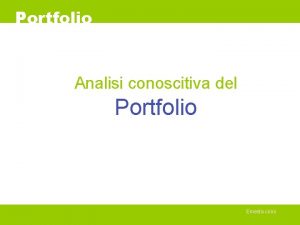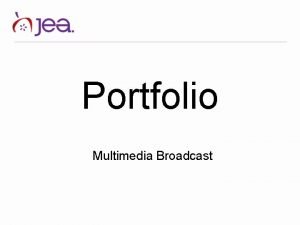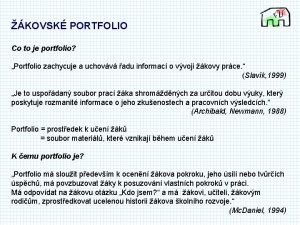Instructional Design Portfolio Katie Conley Contact Katie Conley
































- Slides: 32

Instructional Design Portfolio Katie Conley

Contact Katie Conley Email: conleykatielynn@gmail. com Phone: 415. 706. 1623 Linked. In: https: //www. linkedin. com/in/katieconley Images included in this presentation are copyright Pearson Education.

Through my training in instructional design, I’ve discovered my work as a content manager and project manager on teams creating print and digital educational packages parallels in many ways the role an instructional designer plays building courses. Here I’ve used a package created for a college physics course at my previous employer to show you how.

Analysis Before launching into a project, careful planning needs to take place using market feedback, data, and other information to assess audience needs, course goals, budget limitations, technical requirements, etc.

Analysis (continued) We thoroughly assessed the audience at the outset to identify their needs and goals for the course, created a budget, and took a look at existing content: • We surveyed college physics students and instructors via questionnaires and focus groups. • We analyzed data from our online homework system to assess the quality of the homework problem set. What were the strengths? What needed improvement?

Analysis (continued) We learned the following: • College physics students are mainly extrinsic learners. The majority of students taking the course are on a pre-med path and they’re primarily motivated to get an A, not necessarily to learn physics. • According to instructors, students do not read the text start to finish. • Problem-solving is central to the course. Students want ample opportunity to learn and practice this skill.

The Plan • We used our market feedback to arrive at a plan to address student and instructor needs, taking into account the issues we uncovered through our market research. Solutions to each one were incorporated into the products we mapped out. • The package included a print text, an e. Text, an online homework system, and a suite of videos and other digital assets available for self-study, lecture preparation, and assessment.

The Plan (continued) The issue: • Students, mainly biology majors, just want to get an A so they can get into med school. The solution: • We provided lots of biological and real-world applications to capture the interest of pre-med students and biology majors as well as homework problems to practice for the MCAT exam. • The applications were included in a variety of formats.

The Plan (continued) The issue: • Students don’t read the text start to finish. The solution: • Content was broken into small chunks with lots of reinforcement along the way. • Prelecture videos allowed students to prepare for lecture, supplement their reading, and fill in gaps.

The Plan (continued) The issue: • Problem solving is a key skill required to pass the course. Students want ample opportunity to learn and practice. The solution: • Each chapter included multiple types of problem-solving boxes with varying levels of guidance to give students plenty of opportunity to learn and practice. • We also provided a suite of videos online for further selfstudy and practice.

Design The content package was mapped out, organized, and structured taking into account student attention spans, cognitive load, and the need for evaluation and reinforcement.

Reinforcement Students benefit from having concepts reinforced and repeated in a variety of ways.

Reinforcement (continued) Several features in the text and e. Text reinforce concepts and enhance learning and give students an opportunity to check their understanding.

Reinforcement (continued) Big Ideas open each chapter and repeat at relevant points in the text to expand upon and reinforce concepts.

Reinforcement (continued) Section reviews briefly encapsulate key concepts at the end of each section to reinforce lessons learned.

Reinforcement (continued) “Enhance Your Understanding” questions at the end of each section allow students to check their understanding of content (with answers provided) before moving on.

Evaluation and Motivation Students and instructors need assessment opportunities to measure their success in the course and to stay motivated.

Evaluation and Motivation (continued) An online homework system with an automatic grading feature and built-in coaching gives students immediate feedback on assignments. Success is based on the number of correct answers and the number of hints requested to get the right answer.

Evaluation and Motivation (continued) Instructors get data immediately— “just in time” —on each problem assigned and can see which ones cause students to struggle based on time spent solving them, right/wrong answers, etc. Using this data, instructors can revise their course and give additional time to areas of weakness to ensure their course is a success.

Evaluation and Motivation (continued) Students can watch and engage with problem-solving videos to prepare for lecture. Assessment is built in to let them know how they’re doing.

Practice Students need ample opportunity to practice and apply what they’ve learned in order to retain information. Otherwise, skills and information will be quickly forgotten.

Practice (continued) Each chapter includes multiple problem-solving examples with varying levels of guidance. Students can see problems worked out step by step and engage with a variety of partially solved problems.

Practice (continued) A suite of instructional and interactive pause-andpredict videos gives students an opportunity to study further and practice problem solving on their own.

Variety Students benefit from a variety of instructional formats and methods to engage with content.

Variety (continued) Instructor-led whiteboard videos can be viewed via QR code from the textbook or clicked on in the e. Text for further problem-solving instruction and self-study in a different format.

Variety (continued) QR codes in the margins at relevant points allow students to view videos on their smartphones that show physics concepts discussed in the text applied in demonstrations.

Variety (continued) Photos show real-world examples of complex physics concepts, bringing them to life and making them easier to understand.

Cognitive Load Students learning new concepts need content delivered in manageable chunks, with little distraction, and in formats that allow them to focus on what’s important.

Cognitive Load (continued) Content is broken into short sections. Brief reviews at the end of each section encapsulate key concepts to reinforce learning and give students an opportunity to pause and reflect.

Cognitive Load (continued) Art is an important tool for learning but it can be difficult for students to know where to focus. Concise annotations placed on figures point to the physics and explain it, keeping students focused on what’s important.

Additionally, my relevant experience includes: • 508 -compliant content • Hiring and managing SMEs • Copy editing and proofreading • Providing instructions to artists to render art (storyboarding) • Creating and managing budgets • Serving as the main point of contact for content experts and instructors throughout a project

Contact Katie Conley Email: conleykatielynn@gmail. com Phone: 415. 706. 1623 Linked. In: https: //www. linkedin. com/in/katieconley
 Katie conley model
Katie conley model Phi examples
Phi examples Amber conley
Amber conley Non contact force examples
Non contact force examples Machine design
Machine design Which is a contact force? *
Which is a contact force? * Tension force contact or noncontact
Tension force contact or noncontact Atopic dermatitis vs contact dermatitis
Atopic dermatitis vs contact dermatitis Air resistance contact or non contact
Air resistance contact or non contact Dangling bond in fullerene
Dangling bond in fullerene Difference between high contact and low contact services
Difference between high contact and low contact services Force and motion
Force and motion Air resistance contact force
Air resistance contact force Task analysis instructional design
Task analysis instructional design Systematic design model by robert diamond
Systematic design model by robert diamond Instructional design authoring tools
Instructional design authoring tools Dynamic instructional design
Dynamic instructional design Advantage of assure model
Advantage of assure model Concept of teaching
Concept of teaching öğretim tasarımı çekirdek modeller
öğretim tasarımı çekirdek modeller Kemp design model
Kemp design model Ask fhml
Ask fhml Dick & carey model
Dick & carey model Goal analysis instructional design
Goal analysis instructional design Advantages of arcs model
Advantages of arcs model Gagne 9 events of instruction
Gagne 9 events of instruction Sam instructional design
Sam instructional design Flexspace csu
Flexspace csu Kemp's instructional design model
Kemp's instructional design model Instructional message design
Instructional message design Personal values statement examples for students
Personal values statement examples for students Work immersion portfolio weekly diary
Work immersion portfolio weekly diary Portfolio in mathematics
Portfolio in mathematics
